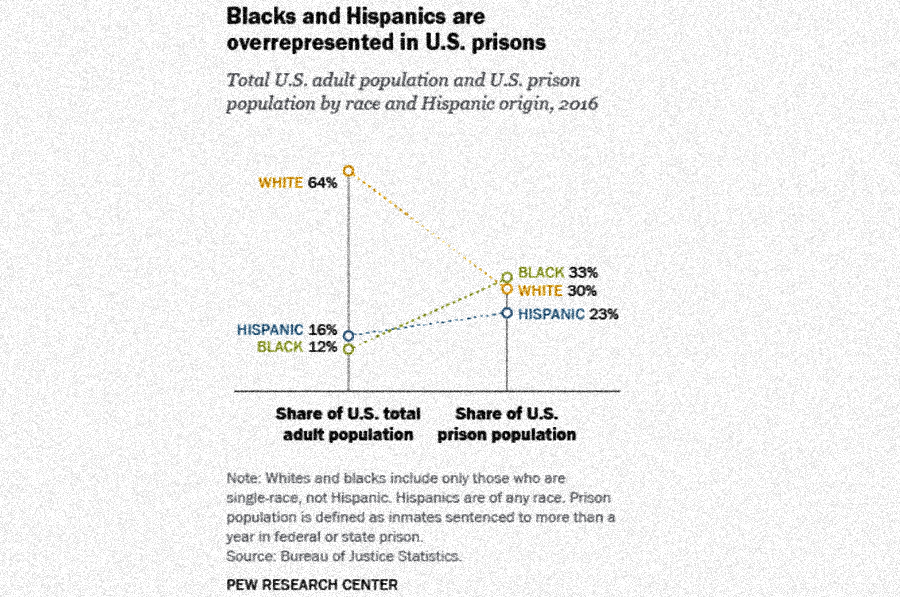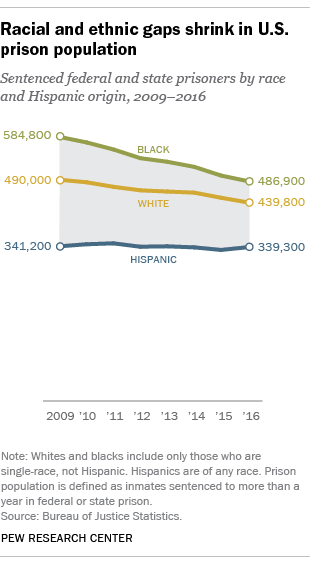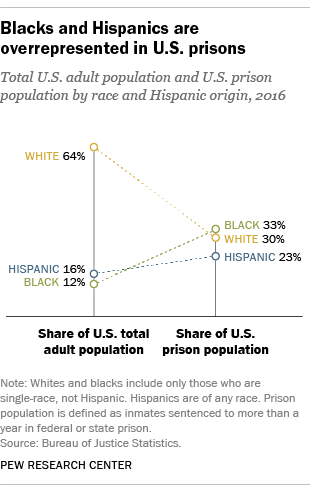The gap between the number of blacks and whites in prison is shrinking

Blacks have long outnumbered whites in U.S. prisons. But a significant decline in the number of black prisoners in recent years has steadily narrowed that gap to the point where it is half as wide as it was in 2009, when America’s prison population peaked, according to new data from the Bureau of Justice Statistics.
 At the end of 2016, federal and state prisons in the United States held about 486,900 inmates who were black and 439,800 who were white – a difference of 47,100, according to BJS. In 2009, by comparison, there were 584,800 blacks and 490,000 whites – a difference of 94,800. (This analysis counts only inmates sentenced to more than a year.) The decline in the black-white gap between 2009 and 2016 was driven by a 17% decrease in the number of black inmates during that span, which outpaced a 10% decrease in the number of white inmates.
At the end of 2016, federal and state prisons in the United States held about 486,900 inmates who were black and 439,800 who were white – a difference of 47,100, according to BJS. In 2009, by comparison, there were 584,800 blacks and 490,000 whites – a difference of 94,800. (This analysis counts only inmates sentenced to more than a year.) The decline in the black-white gap between 2009 and 2016 was driven by a 17% decrease in the number of black inmates during that span, which outpaced a 10% decrease in the number of white inmates.
The gap between white and Hispanic imprisonment also narrowed between 2009 and 2016, but not because of a decrease in Hispanic prisoners. Instead, the number of white prisoners fell while the number of Hispanic inmates remained essentially flat. At the end of 2016, there were 100,500 more white inmates than Hispanic inmates (439,800 vs. 339,300), down from an inmate difference of 148,800 in 2009 (490,000 white inmates vs. 341,200 Hispanic inmates).
Overall, there were 1,458,173 sentenced prisoners in the U.S. at the end of 2016, or about 6% fewer than the 1,553,574 at the end of 2009. Apart from blacks, whites and Hispanics, these totals include inmates from other races and those from mixed racial and ethnic backgrounds. The figures only count people in federal and state correctional facilities, including those held in privately run prisons that contract with the government; they exclude most inmates held in locally run jails.
 The racial and ethnic makeup of U.S. prisons continues to look substantially different from the demographics of the country as a whole. In 2016, blacks represented 12% of the U.S. adult population but 33% of the sentenced prison population. Whites accounted for 64% of adults but 30% of prisoners. And while Hispanics represented 16% of the adult population, they accounted for 23% of inmates.
The racial and ethnic makeup of U.S. prisons continues to look substantially different from the demographics of the country as a whole. In 2016, blacks represented 12% of the U.S. adult population but 33% of the sentenced prison population. Whites accounted for 64% of adults but 30% of prisoners. And while Hispanics represented 16% of the adult population, they accounted for 23% of inmates.
Another way of considering racial and ethnic differences in the nation’s prison population is by looking at the imprisonment rate, which tallies the number of prisoners per 100,000 people. In 2016, there were 1,608 black prisoners for every 100,000 black adults – more than five times the imprisonment rate for whites (274 per 100,000) and nearly double the rate for Hispanics (856 per 100,000).
For all three of these groups, imprisonment rates have declined substantially since 2009. The rate has declined 25% among blacks, 11% among whites and 19% among Hispanics. Experts have offered a range of explanations for the pronounced drop in the black imprisonment rate.
By John Gramlich